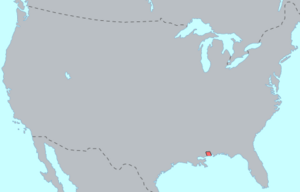Biloxi people facts for kids
| Total population | |
|---|---|
| 951 Tunica-Biloxi Tribe (2010 Census) | |
| Regions with significant populations | |
| Mississippi (historical), Louisiana | |
| Languages | |
| English, French, Biloxi (historical) | |
| Religion | |
| Protestantism, Catholicism, traditional beliefs | |
| Related ethnic groups | |
| Tunica, Choctaw |
The Biloxi tribe is a group of Native American people. They are part of the Siouan language family. They called themselves Tanêks(a) in their own Biloxi language.
When Europeans first met the Biloxi in 1699, they lived near the Gulf of Mexico. This area is now the city of Biloxi, Mississippi. Over time, they had to move west into Louisiana and eastern Texas. Sadly, the Biloxi language, called Tanêksąyaa ade, died out in the 1930s. The last person who spoke it, Emma Jackson, passed away then.
Today, the remaining Biloxi people have joined with the Tunica and other groups. In 1981, the United States government officially recognized them. They are now known as the Tunica-Biloxi Indian Tribe. They share a small reservation in Avoyelles Parish, Louisiana. People from several other small tribes are also part of this group. The Biloxi and Tunica tribes originally spoke different languages. The Biloxi spoke a Siouan language, while the Tunica had a unique language. Today, members of the tribe mostly speak English or French.
Contents
History of the Biloxi People
Not much is known about the Biloxi tribe before they met Europeans in 1699. We learn about them from archeological digs, old stories passed down, and information from related tribes.
First Meetings with Europeans
In 1699, the Biloxi met the French Canadian explorer Pierre Le Moyne d'Iberville. He was setting up a French colony in Louisiana. D'Iberville was told that the Biloxi nation used to be very large. However, a terrible sickness, likely smallpox, had greatly reduced their numbers. This disease left an entire village empty and in ruins.
D'Iberville described finding a deserted village in the late 1600s. The people had been hit by the sickness two years before. The village had remains of cabins made of mud. Their roofs were covered with tree bark. Native Americans had no natural protection against diseases like smallpox. These diseases were common among Europeans.
Ancient Culture and Lifestyle
The Biloxi people were descendants of the Mississippian culture people. These ancient people built large mounds. Even though the Biloxi spoke a Siouan language, their ancestors shared many cultural traditions with other groups in the Southeast. This is what anthropologists call the Southeastern Ceremonial Complex.
The Biloxi were farmers. Women grew different kinds of corn, beans, and squash. Men hunted deer, bear, and bison to add to their food. They also fished all year round.
Leaders and Beliefs
Like many farming societies, the Biloxi had a special way of organizing their leaders. The most important leader was called the Yaaxitąąyą. This means "Great Sacred One." This person could be a king or a queen. They controlled the food storage and how food was shared.
The Yaaxitąąyą had helpers called ixi. The Biloxi word for king or chief, ąyaaxi or yaaxi, was also the word for a medicine man or shaman. This means their leaders were also spiritual guides.
We don't know much about how common people were buried. However, the bodies of important leaders, the ąyaaxi, were specially preserved. Their bodies were dried using fire and smoke. These preserved bodies were placed upright on red poles inside a temple. They would be set near the front entrance. Visitors would offer food to them every day.
Traditional Clothing and Tools
In the late 1800s, an American expert named James Owen Dorsey visited the Biloxi in Louisiana. He studied their culture before Europeans arrived. Men wore a breechcloth, usually made of deerskin. This was a piece of cloth passed between the legs and tucked into a belt. Belts were made of skin or beaded cord.
Men also wore garments on their upper bodies. These were made from the skins of animals like bear, deer, panther, and bison. Some of these were long and used by older people for winter. Women prepared and sewed animal skins to make clothes. They also made moccasins and leggings. Leggings were worn in cold weather or to protect legs from bushes.
The Biloxi made tools and utensils from bison and deer horns. They also wore jewelry made from cut and polished seashells. Some Biloxi people had traditional tattoos on their faces. They also wore nose rings and earrings.
Moving and Merging Tribes
The Biloxi people slowly moved from Mississippi to Louisiana and Texas. They joined with other tribes like the Caddo, Choctaw, and later, the Tunica people.
By the time James Owen Dorsey visited them in the 1890s, much of their old tribal structure had changed. However, they still traced their family lines through the mother's side. This is called a matrilineal system. They had three main clans:
- Ita aⁿyadi, or Deer people
- Oⁿʇi aⁿyadi, or Bear people
- Naqotodc̷a aⁿyadi, or Alligator people
Most Biloxi people identified as Deer people. Dorsey noted that their social system was very detailed. They had more than 53 terms for family relations. This was more than any other Siouan group he had studied.
See also
 In Spanish: Biloxi para niños
In Spanish: Biloxi para niños


